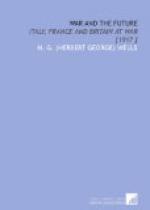One travelled through a choking dust under the blue sky, and above the steady incessant dusty succession of lorry, lorry, lorry, lorry that passed one by, one saw, looking up, the tree tops, house roofs, or the solid Venetian campanile of this or that wayside village. Once as we were coming out of the great grey portals of that beautiful old relic of a former school of fortification, Palmanova, the traffic became suddenly bright yellow, and for a kilometre or so we were passing nothing but Sicilian mule carts loaded with hay. These carts seem as strange among the grey shapes of modern war transport as a Chinese mandarin in painted silk would be. They are the most individual of things, all two-wheeled, all bright yellow and the same size it is true, but upon each there are they gayest of little paintings, such paintings as one sees in England at times upon an ice-cream barrow. Sometimes the picture will present a scriptural subject, sometimes a scene of opera, sometimes a dream landscape or a trophy of fruits or flowers, and the harness—now much out of repair—is studded with brass. Again and again I have passed strings of these gay carts; all Sicily must be swept of them.
Through the dust I came to Aquileia, which is now an old cathedral, built upon the remains of a very early basilica, standing in a space in a scattered village. But across this dusty space there was carried the head of the upstart Maximinus who murdered Alexander Severus, and later Aquileia brought Attila near to despair. Our party alighted; we inspected a very old mosaic floor which has been uncovered since the Austrian retreat. The Austrian priests have gone too, and their Italian successors are already tracing out a score of Roman traces that it was the Austrian custom to minimise. Captain Pirelli refreshed my historical memories; it was rather like leaving a card on Gibbon en route for contemporary history.
By devious routes I went on to certain batteries of big guns which had played their part in hammering the Austrian left above Monfalcone across an arm of the Adriatic, and which were now under orders to shift and move up closer. The battery was the most unobtrusive of batteries; its one desire seemed to be to appear a simple piece of woodland in the eye of God and the aeroplane. I went about the network of railways and paths under the trees that a modern battery requires, and came presently upon a great gun that even at the first glance seemed a little less carefully hidden than its fellows. Then I saw that it was a most ingenious dummy made of a tree and logs and so forth. It was in the emplacement of a real gun that had been located; it had its painted sandbags about it just the same, and it felt itself so entirely a part of the battery that whenever its companions fired t burnt a flash and kicked up a dust. It was an excellent example of the great art of camouflage which this war has developed.




